
Lima tank plant faces risk of 3-year production hiatus
6/17/2012
A U.S. Army sergeant directs an M1A1 Abrams heavy-battle tank at Camp New York in the Kuwaiti desert in 2002 during the buildup before the Iraq war.
general dynamics

A U.S. Army sergeant directs an M1A1 Abrams heavy-battle tank at Camp New York in the Kuwaiti desert in 2002 during the buildup before the Iraq war.
LIMA, Ohio -- Tipping the scales at nearly 70 tons and sporting a sinister 120mm cannon, the M1 Abrams tank is a core weapon in the U.S. military's formidable ground force.
The battle tank is also the foundation for hundreds of jobs in Lima at General Dynamics Corp. Land Systems' Joint Systems Manufacturing Center, the only place on Earth where workers build and refurbish the Abrams. But the program and the jobs it supports are again at risk, sparking a fight that has aligned Congress, General Dynamics, and Lima-area officials against the White House, the Army brass, and the Pentagon's bean counters.
For the second year in a row, the Army's budget request has included nothing for building new or upgrading existing Abrams tanks. And for the second year in a row, Congress is trying to give the program millions of dollars anyway.
It's not that the Abrams, which entered service in 1980, is obsolete. Far from it, in fact. Defense experts still consider it among the top tier -- if not the best -- of battle tanks in the world. It's so good that the Army intends to use upgraded variants of the tank until at least 2050. But for now, the Army says its orders have been filled and the current tank fleet is up to date to current specifications.
The Army originally wanted to idle its Abrams orders from 2013 until 2017, when it plans to unveil its next-generation Abrams tank. However, Congress approved $255 million last year that gave General Dynamics work to upgrade 46 tanks. The Pentagon has again this year requested no additional funding for the Abrams until 2017, meaning U.S. orders would dry up in June, 2014.
Plant supporters say that plan softens national defense, costs the Army more money than it saves, and harms the industrial base and supply chain.

Workers put a turret on an Abrams tank at the General Dynamics Land Systems Joint Systems Manufacturing Center in Lima. The Army intends to use upgraded variants of the tank until at least 2050, but its orders have been filled and the current tank fleet is up to date according to current specifications.
"It makes no sense to stop a program for four years and start it up in 2017," Rep. Marcy Kaptur (D., Toledo) said. "That is a draconian cut, and it essentially kills all the suppliers that create the supply chain in tank production. The accountants don't really care about that, so Congress has to look at the impact on the over-ground system and try to make other changes in the budget that yield the same result but without killing one of the Army's key programs."
Miss Kaptur's 9th District doesn't include the tank plant, but she is a member of the House Appropriations Defense subcommittee and has lent heavy support to the facility.
Specialized workers
As recently as three years ago, the plant, which also builds Stryker armored vehicles, employed about 1,250 people.
After 200 layoffs this year, that number is down to about 840. It's expected to shrink more this year as work slows.
"These are very good-paying, highly skilled jobs," Lima Mayor David Berger said. "It's a significant employer with a demand for skill sets that would not be in demand at other locations because of the uniqueness of their product. You don't go to school and get a degree in building Abrams tanks. You get your experience, your expertise, in actually building them."
Mr. Berger and others worry that laid-off workers, unable to find work that suits their skills in Lima, 75 miles south of Toledo, would leave town. They argue retraining workers after a three-year lull would be costly in time and money.
A pause in production would hurt the Abrams' roughly 880 suppliers, many of which General Dynamics says are small companies.
Bob Block, the owner of Block Industrial Service Inc. in the Toledo suburb of Northwood, supplies tooling to the Lima plant.
"I would classify them as a very good customer," he said. "They would be an 'A' category customer. If something would happen that they would close the plant, it wouldn't be a catastrophe, but we see them as a very good customer. They buy regularly, two or three times a week, and they pay well."
Mr. Block's firm supplies tooling to several machine shops in the region that make parts for the plant. Many of those shops, he said, would be endangered by an Abrams shutdown.
"Those machine shops, that's another story. They have skilled people, tool-and-die makers and programmers for CNC machines, and it's hard to find those people. That would be a problem for the machine shops in the area."
General Dynamics and the military estimate shutting down the plant would cost between $600 million and $800 million. But while the Army projects reopening the plant would cost about $400 million, General Dynamics estimates the cost would be nearly $1 billion.
That's a bill Mr. Berger thinks the Pentagon would be unwilling to pay.
"We believe it will become so expensive to restart, it won't be restarted, and instead those capabilities will be re-established somewhere else," he said.
Foreign customers
Ashley Givens, a spokesman for the U.S. Army, said the army isn't "shutting down" the Lima plant. Rather, the Army is focusing on tank modernization and foreign military sales.
"This production 'pause' of U.S. tanks will allow the Army to focus its limited resources on the development of the next generation Abrams tank instead of building more of the same M1A2 SEPv2 tanks that have exceeded their space, weight, and power limits," Ms. Givens said in a statement to The Blade.
The Army says military sales to countries such as to Saudi Arabia and Egypt should provide enough orders to keep the line running. No one is arguing against those foreign military sales, but lawmakers and others caution against relying on them.
"We're fine with the sales. We just want to make sure the Army doesn't rely on them to keep production going because of the potential interruption," said Sen. Sherrod Brown (D., Ohio). "The volatility of it can go up and can go down, and we need to have something more reliable than that."
Donald Kotchman, vice president of the heavy brigade combat team at General Dynamics Land Systems, said the company has a contract with Saudi Arabia that would ensure work through early 2014. Negotiations for more orders with Saudi Arabia and other countries are ongoing.
"I don't want to overplay or underplay the situation," Mr. Kotchman said. "There is [an] order for Morocco that we have reason to believe will occur; we just don't know when the timing of that will be. What we're trying to do is balance the minimum sustainment rate with enough domestic work to sustain capability across the industrial base -- Lima and the suppliers -- to bridge the gap until the modernization program ... occurs in 2017."
Bipartisan support
Though the Abrams program isn't a current Pentagon priority, it has found significant bipartisan support from Congress. The House version of the 2013 National Defense Authorization Act included $181 million for the Abrams program -- enough to build about 30 tanks. The Senate version included $91 million for the Abrams.
Aside from Mr. Brown, the plant may have no greater champion than Republican Rep. Jim Jordan, whose 4th District includes Lima.
"Things look much more positive now than they did a few months ago," Mr. Jordan said. "But to be realistic, the process is not over, and in this business you never know how it's going to shake out until its done, the bill has been passed through both houses, and the President has his signature on it."
That signature might prove difficult to obtain.
The House approved $643 billion for defense, an amount the White House's Office of Management and Budget says would violate the Budget Control Act of 2011. That could lead to the President vetoing the bill, officials say.
Though Mr. Jordan emphasizes that he cares about jobs in his district, he has built a reputation as a budget hawk and a big supporter of national defense.
Asked about the impact to Lima's economy, he gives a quick response about the importance of jobs before doubling down on the defense angle.
"First and foremost, the one thing that Congress is supposed to spend taxpayer money on ... is defense of the country. Part of national defense is tanks. While there's jobs and all that is important -- I understand that -- we should make decisions based on the best interest of the nation, not [congressional] districts, and in the best interest is a strong national defense. Included in that is tanks."
Lima mainstay
Tanks have been part of Lima's rich industrial history since World War II, when the Army established a depot about three miles south of the city's downtown square. At its war-time peak, the plant employed more than 5,000 people.
The site remains U.S. government property, with defense contractor General Dynamics Corp. the current operator.
If Lima loses the Abrams, it is unclear what the future would be for the plant.
As long as General Dynamics had enough work through its other programs and foreign sales, work would go on.
Asked about the future of the plant, Mr. Kotchman said: "We will continue to work on efficiencies within the facility to try to position ourselves as best we can for the business we know we have, and then beyond that it's unpredictable. If the plans come in as projected, then there's still a future for Lima."
As for a weakening of American's defense capabilities, Nelson Fisk, a senior aerospace and defense analyst with IHS, doesn't see it.
"I don't think it's as grave as people think. We're not going to lose our ability to produce a tank. I think General Dynamics could produce a tank even if there was a delay of three years and it was shut down to zero. I don't think that's going to happen, though."
The military is reducing its presence in Afghanistan, and the face of war has shifted from tank-on-tank battles.
Mr. Fisk says one reason the Army has been adamant -- at least publicly -- that it doesn't want any Abrams funding is because they are trying to divert as much money as they can to a project called the Ground Combat Vehicle, which is being developed.
Still, Mr. Fisk doesn't see them leaving money on the table.
"I see them compromising, because the Army is going to have difficulty saying 'no way, we're not taking one dime more.' "
Contact Tyrel Linkhorn at: tlinkhorn@theblade.com or 419-724-6134.